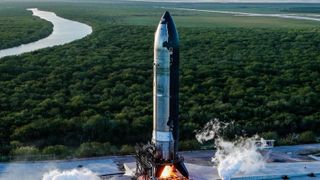SpaceX's Starship Flight 7 test flight will deploy simulated Starlink satellites for 1st time
Starship aims to deploy simulated Starlink satellites during Flight Test 7.

SpaceX is ready for the next Starship flight test, aiming to make strides toward full reusability of the launch system at the start of what promises to be a massive year for the launcher.
Launch from Starbase Orbital Launch Pad A in South Texas is currently scheduled for 5:00 p.m. Eastern (2200 GMT) Jan. 10. The launch window will be open for 97 minutes, with backup days running to Jan. 16. You'll be able to tune into the livestream on Space.com, if SpaceX makes it available as usual.
Starship consists of the massive first stage called Super Heavy and an upper-stage spacecraft known as Starship, or simply "Ship." The launch from Boca Chica Beach will feature a number of new upgrades and objectives, building on the spectacular Flight Test 6 in November of last year.
Most notably, this will be the first time SpaceX attempts to deploy payloads with Starship, using 10 Starlink simulators to test the system's ability to deploy active next-generation Starlink satellites in the future. Deploying next-gen, heavier and more advanced Starlink satellites will be one of the uses of Starship.
The simulators will be on the same suborbital trajectory as the Starship upper stage, with Ship targeting a splashdown in the Indian Ocean.
In terms of upgrades, the flaps on the Starship upper stage are reduced in size and closer to the tip of the vehicle, reducing their exposure to heat and allowing simplified protective tiling, while redesigns to the propulsion system allow a 25% increase in propellant volume, SpaceX revealed in a statement.
"The ship's heat shield will also use the latest generation tiles and includes a backup layer to protect from missing or damaged tiles," the statement says.
Get the Space.com Newsletter
Breaking space news, the latest updates on rocket launches, skywatching events and more!
Super Heavy, meanwhile, will be reusing Raptor engine number 314, which flew on Booster 12 and was spectacularly caught by the tower chopsticks on Flight Test 5, in a small step toward reusability.
The aim is for Super Heavy — the 14th booster of its kind — to make a return to the pad for a catch attempt. If the necessary conditions are not met, however, the booster will instead head for the Gulf of Mexico for a landing burn and soft splashdown.
Starship Die Cast Rocket Model Now $47.99 on Amazon.
If you can't see SpaceX's Starship in person, you can score a model of your own. Standing at 13.77 inches (35 cm), this is a 1:375 ratio of SpaceX's Starship as a desktop model. The materials here are alloy steel and it weighs just 225g.
The tower has also received upgrades. It will test radar sensors for increased accuracy when determining the distances between the chopsticks and returning vehicle, while there are also improved sensor protections to prevent damage observed in previous launches.
"This new year will be transformational for Starship, with the goal of bringing reuse of the entire system online," SpaceX said in the statement. The company aims to fly increasingly ambitious missions, building towards sending humans and cargo into orbit around the Earth, as well as on to the moon and Mars.
Join our Space Forums to keep talking space on the latest missions, night sky and more! And if you have a news tip, correction or comment, let us know at: community@space.com.

Andrew is a freelance space journalist with a focus on reporting on China's rapidly growing space sector. He began writing for Space.com in 2019 and writes for SpaceNews, IEEE Spectrum, National Geographic, Sky & Telescope, New Scientist and others. Andrew first caught the space bug when, as a youngster, he saw Voyager images of other worlds in our solar system for the first time. Away from space, Andrew enjoys trail running in the forests of Finland. You can follow him on Twitter @AJ_FI.
-
jan.wolitzky "The simulators will be on the same suborbital trajectory as the Starship upper stage, with Ship targeting a splashdown in the Indian Ocean." There is no practical use for suborbital communications satellites. But what application does use suborbital re-entry vehicles? Hmmm. . . . Let's see, the world's richest man, taking an increasing role in international politics, flexes his rocket company muscles. Sounds like a James Bond plot, no?Reply -
Jim Franklin Replyjan.wolitzky said:"The simulators will be on the same suborbital trajectory as the Starship upper stage, with Ship targeting a splashdown in the Indian Ocean." There is no practical use for suborbital communications satellites. But what application does use suborbital re-entry vehicles? Hmmm. . . . Let's see, the world's richest man, taking an increasing role in international politics, flexes his rocket company muscles. Sounds like a James Bond plot, no?
Its about mass, the simulated payload will likely be the shell of a starling filled with an inert material to simulate the actual mass of a fully operational satellite. This is connected to fuel load, maneuvering in orbit and other factors they need to verify before actually using the rocket to launch real hardware.
I would imagine that they may use STF-8 as a real orbital launch and put real satellites into orbit if this goes successfully. -
Unclear Engineer The suborbital flights will probably continue until SpaceX has demonstrated a number of things with StarShip, including restarting the engines while in zero G, and getting the parts that need to be caught by the "chopsticks" to apparently survive the reentry in good structural condition. Then they can put it into orbit and be confident that they can deorbit to land at Boca Chica, with some hope of being able to catch it intact instead of "landing" it in the Gulf of Mexico.Reply
